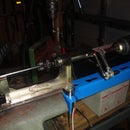Introduction: LED Sign
You will need to design your LED board separately since the sign will be any word or name you choose.
Step 1: Bill of Materials
Components
- Capacitor .1uf
- Capacitor 10uF
- Capacitor 1uF
- PIC16F88
- 7805T TO220H
- Resistor 4.7K
- 5MM LED's
- Several resistors: 50, 150, 250, 350 Ohms
Hardware
- Wire
- Single sided copper clad board large enough for the LED sign
- 3" x 3" Single sided copper clad board
- PIC burner
- 9 Volt DC adapter
- Jal compiler: http://www.casadeyork.com/jalv2/
- Eagle software: http://www.cadsoftusa.com/
- LEDSign.jal
- LEDSign.hex
PCB making
- Paint thinner
- Hydrogen Peroxide
- Meuratic acid
- Laminator
- Laser Printer
- LEDSign.sch and LEDSign.brd
Step 2: Build Controlling PCB
There will be 2 PCB's: the controlling PCB and the LED sign PCB.
The controlling PCB houses the microcontroller, the darlington array,
and the 5 volt regulator.
Download and Print LEDSignBoard.pdf using a laser printer on glossy paper.
You can download and import LEDSign.sch and LEDSign.brd into Eagle
to further modify the schematic and board.
Transfer the image to a copper clad board using a laminator. Drill holes
for the components. Etch the board with an acid solution.
Remove toner using paint thinner and solder in the components.
Reference other instructables on how to manufacture a PCB for more details.
The board I designed provides for 7 letters and uses 7805 to provide 5 volts
for the microcontroller. It also provides for a push button to turn off and on the lights.
Step 3: Build LED PCB
To design theLED sign, I wrote large letters in Eagle as a guide to where the LED's should go.
First draw a schematic of your LED's in series and parallel for each letter with appropriate resistors and then
design the board by rearranging the LED's to coincide with each letter. The idea is for your board to have
1 pad that receives 9 volts, or whatever voltage your power supply provides. This then is routed to
the positive side of each and every letter in your LED sign The negative side of each letter is then routed
to a seperate pad. These ground pads each get connected to the controlling PCB. A letter gets lit
when ground is supplied by the transistor array as controlled by the microcontroller.
Step 4: Programming the Controlling Board
Download and burn LEDSign.hex to the PIC16F88. It will control 6 letters in different patterns.
The programs uses the push button for going to sleep (off) when pressed and is awakened (on)
when pressed again since pushing it triggers an interrupt which wakes up on change.
Download LEDSign.jal and you can easily modify the code to create your own patterns or work
with more letters. The program itself is very basic and so it should port easily to other platforms.
If you do port it, feel free to post back and share.
JAL is a free and easy to use language for PIC's.
You can download the compiler from here: http://www.casadeyork.com/jalv2/
So there you have it. I hope you see the light. Now go and build your own signs.
Attachments

Participated in the
Microcontroller Contest

Participated in the
LED Contest















